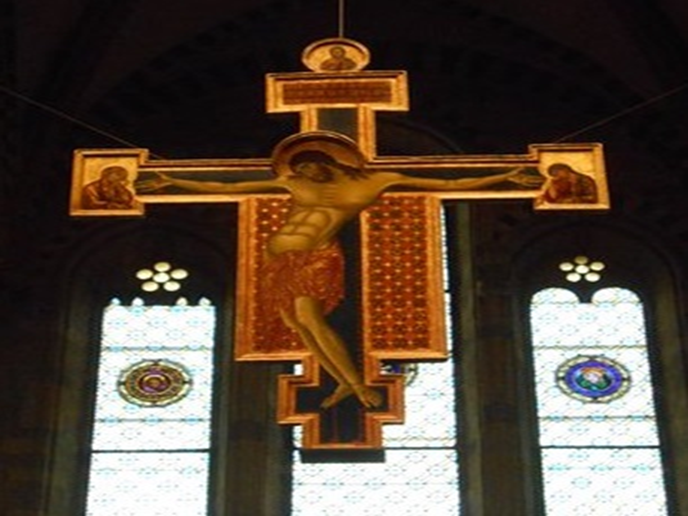St. Dominic of Arezzo: History and Cultural Significance
The Basilica of San Domenico in Arezzo, where Cimabue’s Crucifix is preserved, is a historic building of great cultural and religious significance. Construction of the church began in 1275 at the behest of the Dominican order, and was completed during the 14th century.
This place of worship is known not only for its simple but elegant Gothic architecture, but also for the many works of art it preserves inside. The basilica has played a crucial role in the spiritual and community life of Arezzo, hosting important events and serving as a place of reflection and prayer. The presence of Cimabue’s Crucifix adds further prestige and significance to this historic monument.
Hints of Pepo, known as Cimabue: Master and Innovator
Cimabue, born Cenni di Pepo, is a central figure in the evolution of 13th-century Italian art. Born in Florence around 1240, Cimabue is celebrated for introducing a new realism and greater expressiveness in sacred representations, moving away from the dominant Byzantine style.
His ability to depict suffering and humanity in his subjects is evident in the Crucifix of San Domenico in Arezzo, one of his earliest known works. His career was marked by works that marked a turning point in medieval art and influenced subsequent artistic developments in the Renaissance.
Features of the Crucifix of San Domenico
Cimabue’s Crucifix, housed in the Basilica of San Domenico in Arezzo, is a cross painted in tempera and gold on panel, measuring 336×267 cm. This work, datable between 1268 and 1271, is one of the earliest attributed to the Florentine master and marks a significant departure from the Byzantine style toward greater expressionism.
The depiction of Christ, with a strongly arched body and an expression of intense pain, highlights Cimabue’s ability to blend realism and spirituality. The drapery of Christ’s body and the gilded decorations show the influence of Giunta Pisano, but the work is distinguished by the particular drama and dynamism of the central figure.
Cimabue and the Realistic Turn in the Crucifix of San Domenico
Cimabue’s Crucifix represents a significant turning point in 13th-century artistic realism. Compared to the static and hieratic representations of the Byzantine tradition, Cimabue introduces unprecedented dynamism and emotional depth.
Christ’s body is depicted in a contorted position, with detailed musculature and hands flattened on the cross, creating a strong visual impact. The soft brushstrokes on the face and the use of golden streaks in the drapery add an effect of light and shadow that makes the figure more alive and present. This innovative style influenced many later artists, marking a milestone in the evolution of medieval painting.
The Restoration of the San Domenico Crucifix: A History of Recovery
Cimabue’s Crucifix has gone through various restorations over the centuries. After being created between 1268 and 1271 and maintained in the Basilica of San Domenico in Arezzo, the work underwent its first significant restoration in 1917.
This intervention was essential to stabilize the structure and restore the faded colors. A more recent restoration, carried out in 2005, used modern techniques to repair the damage caused by time and improve the visibility of the original details. These restorations have allowed the Crucifix to continue to be admired and studied as one of the masterpieces of medieval art.
Cimabue and the Byzantine Roots: Evolution and Rupture
In his Crucifix of San Domenico, Cimabue demonstrates an ongoing dialogue with the Byzantine roots of his artistic formation. Although influenced by Byzantine representations of Christ, Cimabue introduces important innovations that signal a break with tradition. Christ’s dramatically arched body and the use of soft, luminous brushstrokes give the figure a three-dimensionality and vibrancy absent in the more rigid Byzantine works.
The gilded decorations in the drapery, an element derived from Byzantine icons, are reinterpreted with a new sensibility, blending religious symbolism with an emerging realism. This mix of tradition and innovation marked an important step toward the development of Western art.
Dramatic Realism in Cimabue’s Crucifix
In the Crucifix of San Domenico, Cimabue infused a dramatic realism that distinguishes this work from traditional Byzantine representations. The body of Christ, depicted in an arched position, with detailed muscles and hands, conveys tangible suffering.
Christ’s face, with soft brushstrokes, expresses human pain, inviting the viewer to empathize deeply. The golden streaks in the drapery add a sacred luminosity, while the use of red emphasizes the sacrifice. This realism not only makes the scene more immediate and engaging, but also reflects Cimabue’s ability to fuse religious symbolism with a more human and accessible representation.
Amiring Cimabue’s Crucifix: Guide to the Visit
For those who wish to see Cimabue’s Crucifix up close, a visit to the Basilica of San Domenico in Arezzo is a must. The church, located in the heart of the city, is easily accessible and offers an atmospheric setting to admire this and other medieval works of art.
The basilica is open to the public daily, with hours that may vary, so it is advisable to check in advance. In addition to the Crucifix, visitors can explore the rich 14th-century pictorial decoration and other significant works. Guided tours are available for those who want a more in-depth experience, providing historical and artistic context to the works on display.
From the B&B One Hundred Steps From the Duomo: An Experience Not to Be Missed
Dear guests of the B&B Cento Passi Dal Duomo, we invite you to complete your stay in Arezzo with a visit to the Basilica of San Domenico. You cannot miss Cimabue’s magnificent Crucifix, a masterpiece that represents a turning point in medieval art. Discover the beauty and spiritual depth of this extraordinary work during your trip to our enchanting city.

